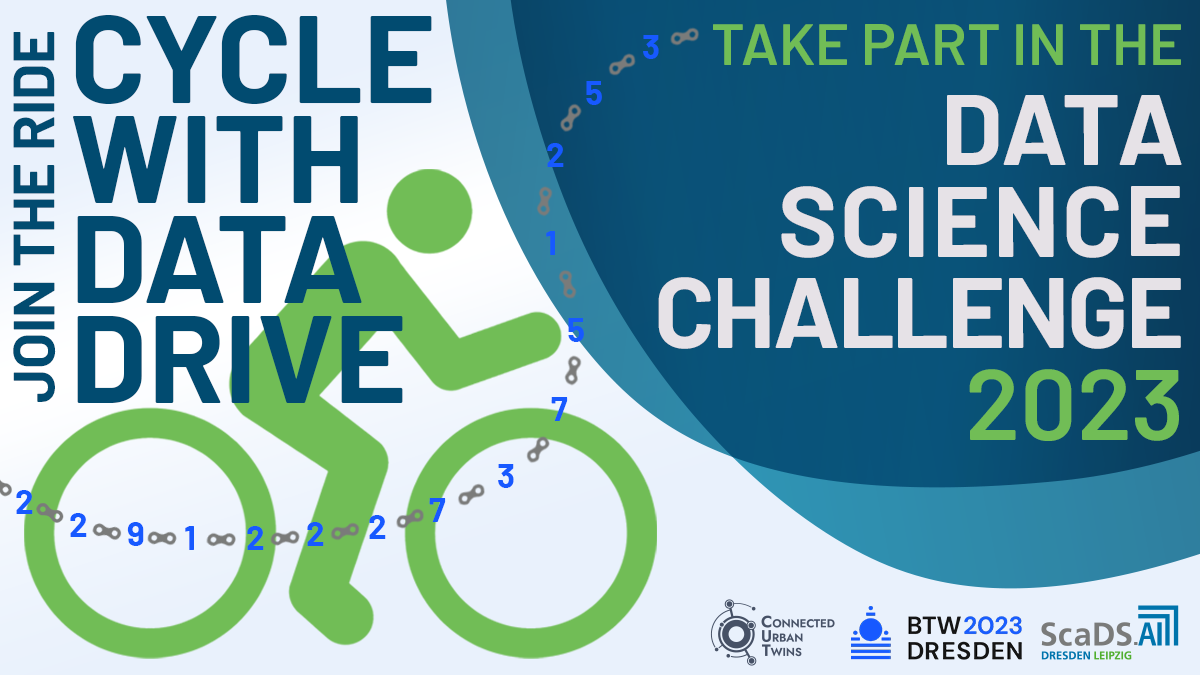Data Science Challenge 2023
Cycling enthusiast and data lover? Are you a student in a higher semester or a Ph.D. student? Are you able to integrate and analyze data sources? If so, participate individually or in a team in the Data Science Challenge, create a cloud-based data analysis on the topic of “cycling with data drive” and develop an innovative concept for the traffic transformation of tomorrow.
The Data Science Challenge
Get on your bike and go!
A good bicycle infrastructure forms the basis for sustainable, environmentally friendly, and resource-saving mobility in urban areas. However, the traffic transformation is only progressing in very small steps. With our Data Science Challenge, we want to open up new perspectives and fields of action with the analysis of digital bicycle data.
Surely cyclists who are on the road every day know exactly the problem areas of cycling in their own city: How to avoid large, unsafe streets? Where does the bike lane suddenly end in a pothole? How to get from A to B with as much green view and as little bicycle and car traffic as possible? While this is the knowledge that each individual bicyclist carries within themselves, analyzing publicly available urban bicycle traffic data and other urban geographical data can help us connect individual perspectives to analyze the big picture of urban bicycle infrastructure.
Are you up for playing around with urban traffic and bike data to come up with new ideas and ways to analyze bike traffic in specific areas? You want to develop innovative concepts for tomorrow’s traffic turnaround? Then join our Data Science Challenge!

Task
Choose a metropolitan area or a city with a sufficient density of sensors and other publicly available geodata for your analysis. In the linked document you can find exemplary data sources from Berlin, Munich, Hamburg, Dresden or Leipzig. Make sure that only trustworthy sensors are used, which do not provide false readings and have only a few dropouts in the recordings. If necessary, blend the data from different sources and clean them to ensure data quality.
Find interesting facts and patterns in the data sources and create an analysis that answers a question of social relevance. Possible initial approaches might include:
- How has bicycle traffic changed over the last 5 years?
- What factors influence measured bicycle traffic volumes? Can the volume be linked to specific events and thus predicted?
- What factors and local conditions help predict bicycle traffic on specific street segments? Can the environment (e.g. the location of residential areas, shopping facilities, schools, train stations, bus stops, universities, and the structure of the road network, bicycle routes, district routes, and narrow sections at bridges) be used to infer where heavy bicycle traffic can be expected? Can a model be developed for this purpose that can be transferred to other cities?
- Is there a correlation between population structure, election results, and other sociodemographic factors in city districts and the volume of bicycle traffic at specific measurement points?
- Can correlations between measured bicycle traffic volumes and weather events, such as snow, rain, or heat, be demonstrated? Can recommendations for action be derived from this?
The result of the analysis can optionally be visualized or presented in purely textual form, for example as a recommendation for action. You decide which technologies, cloud services, and cloud technologies are used. The approach can integrate available services and tools or develop new ones.
Criteria for prototype/concept evaluation
- Novelty and implementability of results: how significant is the potential for predicting bicycle traffic at previously unmeasured waypoints, transferability of predictive models, if applicable
- Completeness/scope of results
- Social relevance
- Data visualization
Application
Apply via ConfTool by submitting your initial research approach by January 28, 2023. Describe your concept and the technologies used on two pages. Include your own relevant prior work or experience in the field, if applicable. Participation in the Data Science Challenge requires at least one person per team to be registered for BTW to present results at the event.
Sequence and schedule
- January 28, 2023: Application deadline for submission of initial concept approaches
- February 14, 2023: One month before BTW 2023, the approved participants will be announced and will receive initial feedback on the submitted concept. You will then have one month until BTW 2023 to integrate the feedback and refine the solutions.
- March 06-10, 2023: The submitted results will be presented as a presentation at BTW and winners will be announced
- March 13, 2023: All participants are invited to submit a scientific paper about their concept
Presentation and award ceremony
At BTW 2023 in Dresden, you will present your results, which will be evaluated by a jury of experts. The jury consists of representatives from research, cities and industry. First to third place will be rewarded with prize money from a pool of 1000 euros.
The jury consists of representatives from:
- ADFC (requested)
- City of Leipzig
- ScaDS.AI Dresden/Leipzig
- CitySienceLab, HCU Hamburg
Cooperation partners
The Data Science Challenge 2023 is carried out by ScaDS.AI Dresden/Leipzig in cooperation with BTW 2023 and the CUT (Connected Urban Twins) project of the City of Leipzig.


